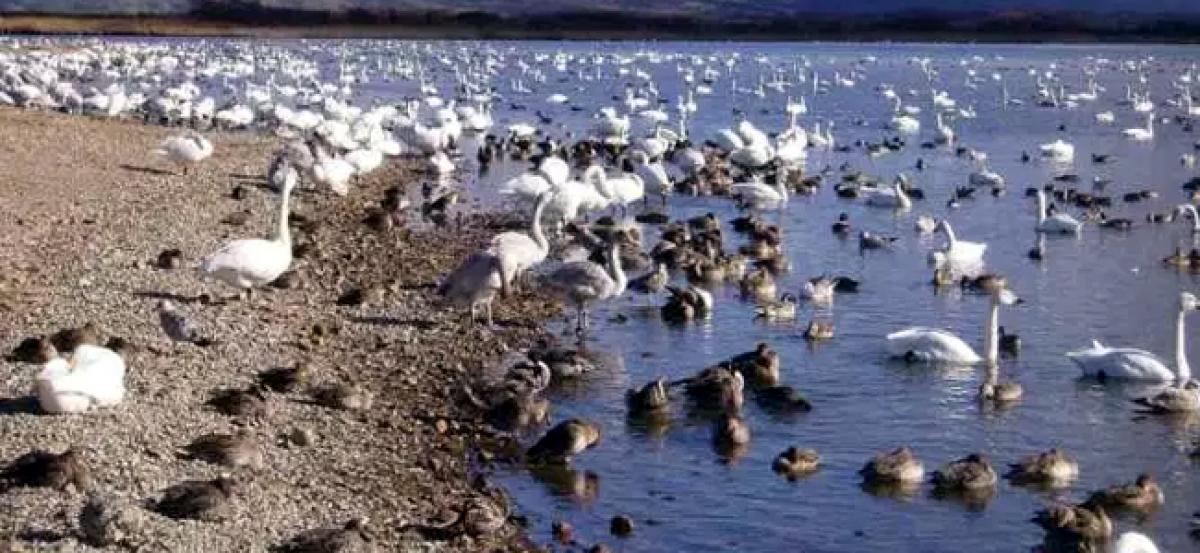Live
- Vaazha Movie Review: A Refreshing Comedy with a Deeper Message
- Mahesh Babu Donates Rs 50 Lakh to CM Relief Fund for Flood Victims
- Teenagers 17/18 is streaming on Aha
- Ex-TTD chief strongly refutes charges made by Chief Minister
- Telugu film’s entry to Oscars 2025: Announcement expected today
- Sundeep Kishan’s next titled as ‘Majaka’; set for Sankranthi 2025 release
- Manair Chairman announces candidacy for Legislative Council elections
- Amazon Great Indian Festival Sale: Dates, Bank Offers, Discounts, and More
- Pawan Kalyan resumes ‘Hari Hara Veera Mallu’ shoot, team announces new release date
- Vaazha: Comedy-Drama Film Starts Streaming on OTT Platforms
Just In
Scientists study the spreading of influenza through flocks of famished birds


Huge flocks of famished birds scour the sands of Delaware Bay for the tiny greenish eggs as an army of horseshoe crabs lays every spring. \"Eventually, we would like to be able to predict which would be the next pandemic,\" said flu pioneer Robert Webster of St. Jude Children\'s Research Hospital.
MIDDLE TOWNSHIP, N.J.: Huge flocks of famished birds scour the sands of Delaware Bay for the tiny greenish eggs as an army of horseshoe crabs lays every spring. "Eventually, we would like to be able to predict which would be the next pandemic," said flu pioneer Robert Webster of St. Jude Children's Research Hospital.
These gentle beaches turn into a mixing bowl for influenza between mid-May and early June, as thousands of shorebirds and gulls crowd together and spread viruses. Researchers carefully step around the nesting crabs to find some evidence regarding potentially flu-infected bird droppings.
"We have trained our eyes for this, that's for sure," said St. Jude researcher Pamela McKenzie as she bent over damp sand last month in search of the freshest samples to go on ice for later testing.
Usually wild birds don't get sick, simply trading flu viruses they carry in the gut. But strains from wild birds can threaten the domestic chickens and turkeys, and jump to pigs or even people every now and then.
St. Jude's annual study at Delaware Bay offers a glimpse into little-known efforts around the world - including testing migrating ducks in China and Canada, and live poultry markets in Bangladesh to track how bird flu circulates and changes, information that can help determine what vaccines to make for animals and people.
Most bird flu isn't easily spread to people, stressed McKenzie, who doesn't even wear gloves as she pooper-scooper along a beach before the tide washes back.
Still, "it's amazing how the virus can change so rapidly, what genes they inherit," said McKenzie, who oversees St. Jude's global bird flu surveillance.
"The right virus comes and gets into the right population which happens to fly over the right farm of turkeys which happens at the right time of year where the right farmer picks up the wrong bird - and we're in trouble.” Webster said.
Webster, now an emeritus virologist at St. Jude, made the connection between bird and human flu decades ago when he found some seabirds in Australia carrying antibodies against the strain that caused the 1957 pandemic.
But worry about bird flu as a threat to both poultry farms and humans has grown since a strain named H5N1 spread directly to people in the late 1990s in Hong Kong's crowded live-poultry markets. Cousins of that virus have cropped up, as has another flu named H7N9 that since 2013 has infected more than 1,500 people in China through close contact with infected chickens.
The research is "one way to stay a little bit ahead of the virus, understanding how this virus can change and how much it can change in a quick amount of time is going to be critical for us to make countermeasures like vaccines." Said Marciela DeGrace of NIH's National Institute of Allergy and Infectious Diseases.
"You can hold a bird and say, 'This bird just got here.' They're here to do work," said Alinde Fojtik of the University of Georgia's Southeastern Cooperative Wildlife Disease Study, a longtime flu researcher who this year volunteered her vacation to help count and tag shorebirds.
So that the birds can feast uninterruptedly, the scientists and conservation workers are only ones allowed on their preferred beaches, carefully catching and counting them, testing their overall health and tagging them for tracking as the migration continues.
"I would love to be able to look at the sequence of virus we find in Delaware Bay this year say, 'Uh-oh, that's the guy that's coming.' We're not at that point yet, that's our end goal, to be able to say, 'Uh-oh, here's something we have to worry about.’” Webby cautioned.

© 2024 Hyderabad Media House Limited/The Hans India. All rights reserved. Powered by hocalwire.com






